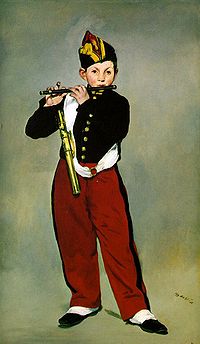Contenidos
Pifano de manet
the fifer painting
The Fifer. Work of the painter Édouard Manet presented to the 1866 Salon. It was rejected by the jury of this Salon. It is currently kept in the Musée d’Orsay in Paris in room 14, level 0.
When Édouard Manet presented this work, he received the umpteenth rejection by the jury. This contrary attitude of official painting towards Manet prompted the writer Émile Zola’s praise of this painting, expressed in an article that provoked protests from readers and the immediate dismissal from his post.
The perfect drawing, which defines all the painter’s work, models the figure and makes it more volumetric. It is remarkable how he takes up again his fondness for contrasts between light and dark tones, which he reinforces by suppressing the intermediate shades.
manet gallery
Édouard Manet (1832-1883) never ceased to feel attracted -and rejected- by critics and official art organizations. He was not a bohemian, his ideal was not to indulge in passions and live with the clothes on his back. At the same time, he was incapable of resigning himself to fit in with what many wanted him to do. He was deeply affected by the harsh criticism of his paintings, but he returned, with his head bowed, to try to be accepted again.
Unlike other artists of his generation, such as Edgar Degas or Paul Cézzane, he believed that exhibiting at the Paris Salon (the official art exhibition of the Paris Academy of Fine Arts) was what an artist should aspire to and he relegated the independent circuits to the background. But the paintings spoke for him and now defend him as an immovable creator: Manet did not want to sacrifice anything to reach fame.
In technique, he practiced radicalism by eliminating halftones without a second thought. The figures had shadows, but Manet gave himself the freedom to use them as he saw fit, and he also established the artist’s right to paint with the colors and tones he liked best, not those that were assumed to be more convenient. That premise, basic but powerful, drove impressionism and changed the course of modern painting.
manet y el impresionismo
En un viaje a España en 1865, Édouard Manet visitó el Prado, donde el arte de Diego Velázquez fue una revelación. A su regreso a París, en 1866, comenzó a trabajar en un nuevo cuadro, que representaba a un anónimo soldado de un regimiento del ejército español. En este cuadro, Manet presenta al muchacho uniformado, de una manera que imita e invierte la fórmula de los retratos de la corte de Vélazquez, sobre un fondo apenas inflexionado y aplanado de tono neutro, frustrando así los intentos de evaluar el verdadero tamaño de la figura y, por extensión, su importancia.
El cuadro, titulado Le fifre, fue rechazado por el jurado del Salón de 1866. Indignado por la decisión del jurado, Émile Zola, uno de los primeros defensores del arte de Manet, publicó una serie de artículos en el periódico L’Évenement, en los que alababa el estilo realista y el contenido moderno de Manet. Siguiendo el ejemplo de Gustave Courbet, en mayo de 1867, Manet financió y montó personalmente una exposición de su propia obra en un pabellón al margen de la Éxposition universelle. La exposición incluía Le fifre, que fue ridiculizada en la prensa popular por sus inusuales pinceladas y su inescrutable ambientación espacial.
wikipedia
Manet painted The Fife influenced by the manner of Velázquez’s portraits that he had admired at the Prado Museum in Madrid. In particular, he was impressed by Pablo de Valladolid, a portrait of a declaiming, actor-like jester of the period, in which the background or any object of reference except the character’s own shadow disappears.[3] Manet wrote to his friend, the painter Henri Fantin-Latour:
Perhaps the most astonishing piece of painting ever made is the painting entitled Portrait of a famous actor in the time of Philip IV. The background disappears. It is air that surrounds the little man, completely dressed in black and full of life.






